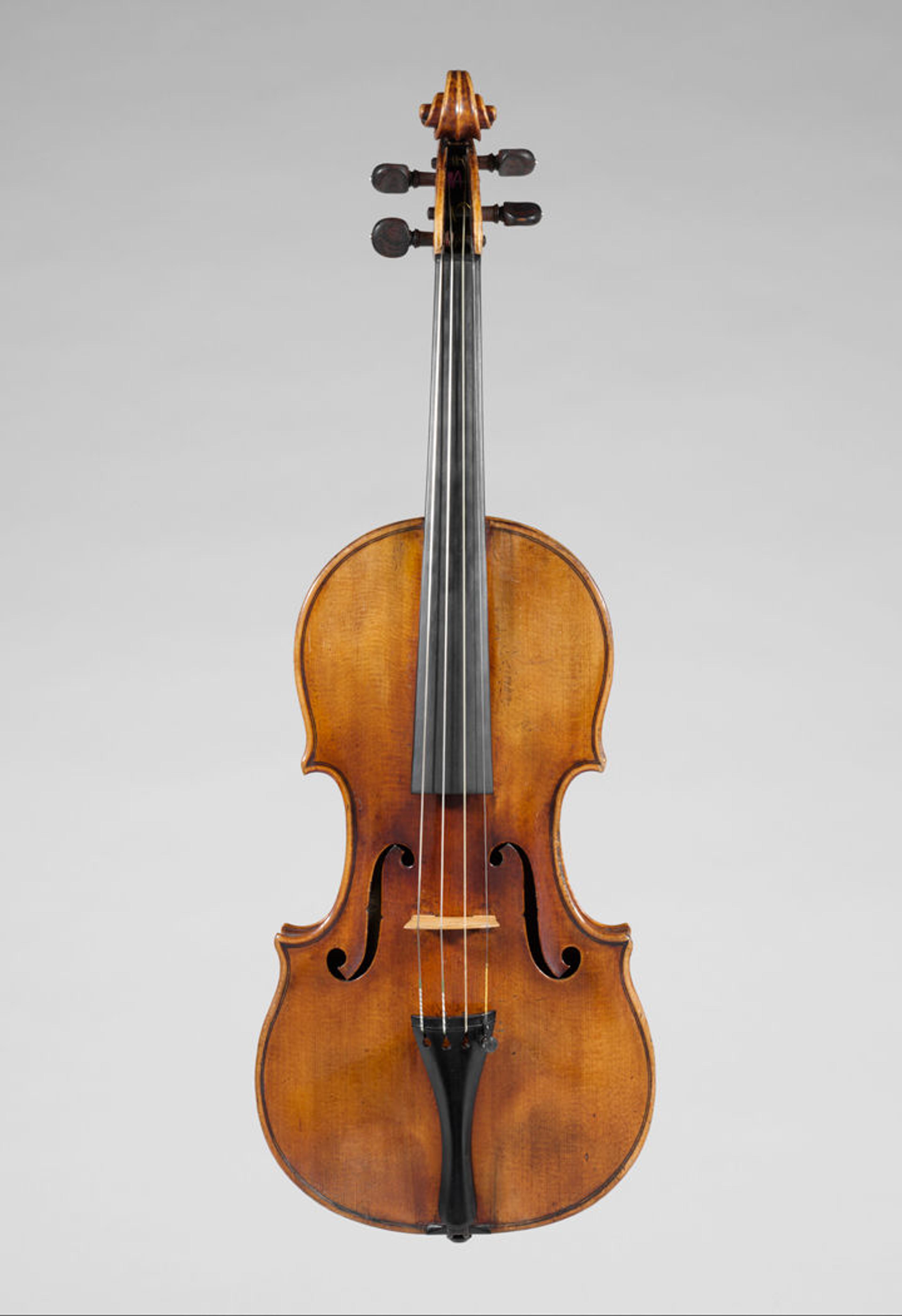Meet Musical Instruments at The Met!

Musical instruments in the galleries at The Met
What does the Met sound like? Next time you're here, close your eyes and listen. Can you hear visitors' footsteps as they go up the stairs in the Great Hall? What about eavesdropping on different languages from around the world: ''Hola, Bonjour, Nihao, Hello''?
The best place to listen at The Met, though, might be in the Musical Instruments galleries. Even though the instruments may look quiet behind the glass, each one was built for sound. With a musician's touch, they can boom, ring, whistle, clap, and sing. What do these instruments sound like? And how do they work?
There are more than 5,000 instruments here, and you can visit about 570 of them in the galleries. They come from all over the world: six continents and the Pacific Islands. Instruments can be grouped into four ''families'' based on how they make sound. Membranophones is the family name for instruments that have a stretched surface, like the skin of a drum, that vibrate to make sound. For chordophones, it's the strings that vibrate. For aerophones, what we hear is the air that's blown through them. Finally, with idiophones, it's the entire instrument that shakes when played by a musician.
Right here, you can listen to three of The Met's instruments and discover how they might be related!
Kamanche

Kamanche, ca. 1869. Iranian (Persian). Iran (Persia). Wood, metal, etc. 36 1/2 x 10 2/8 x 9 in. (92.7 x 25.8 x 22.9 cm). The Crosby Brown Collection of Musical Instruments, 1889 (89.4.325)
Meet the kamanche. If you're a fan of Iranian music, you might already know this instrument. It's played widely across the Middle East and North Africa and thought to be the oldest bowed instrument in the world. The name means ''little bow'' in Persian. (To pronounce it, say ''kay-MAN-cheh.'')
To play a kamanche, a musician holds it upright on its spike and pulls a bow across the strings, similar to playing a small cello. At first the kamanche might soothe you with its warm voice, like a grandfather's whisper. But then it might surprise you, breaking into bright, high notes or plucky beats. Kamanches can be stylish; they are often decorated with paint or tiny pieces of wood and metal. Which details catch your eye? The kamanche's round body, its spike, its strings, its black and white patterns? If you had to guess, where does the sound come out?
Violin

Antonio Stradivari (Italian, 1644–1737). ''The Francesca'' Violin, 1693. Maple, spruce, ebony, mother of pearl. Height: 23 in. (58.4 cm), Width: 8 in. (20.3 cm), Depth (at lower bout): 1 2/8 in. (3 cm). Bequest of Annie Bolton Matthews Bryant, 1933 (34.86.2a)
As the kamanche traveled and spread its sound to other parts of the world, it inspired many other instruments. One example might already be familiar to you. Meet ''The Francesca'' violin. A master Italian violin-maker, Antonio Stradivari, crafted it in 1694.
You might think of ''The Francesca'' violin as a faithful friend who has stuck it out through big changes in the music world. Over three hundred years, performance halls and audiences have grown bigger, and musicians, composers, and instrument-makers have upgraded or replaced some instruments. They've even invented new kinds of music and ways of playing and listening. Yet Antonio Stradivari's design has not changed much. Violinists still play ''The Francesca'' today.
"Liebesleid" by Fritz Kreisler (1875–1962). Performed by Sean Avram Carpenter and Gabriela Martinez, piano
Listen to musician Sean Avram Carpenter play "The Francesca" violin in a concert. Are there parts of a violin that remind you of a kamanche? How do the instruments sound similar or different?
Kamanches and violins both belong to the chordophone family. This is because their sounds both come from the same place: the strings. When a musician pulls a bow across the strings of an instrument, it vibrates and makes sound. The hollow bodies then pick up the sound and make it louder. Chordophone instruments might be round or pear-shaped, made of wood or gut or metal. All of this—their materials and shapes—affects how they sound. Think of any instruments you've played or heard. Do they sound sharp and reedy? Breathy and shallow? Or warm and deep?
Grand Piano

Bartolomeo Cristofori (Italian, 1655–1731). Grand Piano, 1720. Florence, Italy. Cypress, boxwood, paint, leather, fir., Height (total): 34 1/8 (86.5 cm), Width (parallel to keyboard): 37 5/8 (95.6 cm), Depth (case length, perpendicular to keyboard): 90 in. (228.6 cm). The Crosby Brown Collection of Musical Instruments, 1889 (89.4.1219)
You may have seen pianos before, but did you know that at The Met you can meet the world's oldest piano? A man named Bartolomeo Cristofori invented it in Florence, Italy, over 300 years ago.
Watch the video above and you'll see Sasha, our #MetKids reporter and a budding musician, ask Jayson Dobney, a curator, about the story behind it. Listen closely when Jayson plays. This time, where do you think the sound comes from?

Jayson's fingers press the keys to play the world's oldest piano. Inside, can you spot the hammer hitting the strings?
When Jayson presses the keys, small hammers hit strings inside the instrument. Can you find the strings in Cristofori's piano? (Hint: Look under the piano's lid that's propped up).
Surprisingly, it turns out the piano has a lot in common with kamanches and violins. The pianist's fingers strike the keys, but the sound comes from the strings. That makes the piano a part of the chordophone family, too.
Many cultures across the world organize instruments by how they make sound. Yet there are as many ways to group instruments as there are musical cultures and traditions. Igbo peoples in Nigeria group instruments by how they work together to make music. For example, some instruments provide the leading melody, while others keep the beat going underneath.
Other instrument families are based on what they are made of. One of the earliest Chinese systems sorted instruments into silk, bamboo, wood, stone, metal, bone, plant, and hide (animal skin). A Hindu system divided instruments by their shape and how the sound is made: stretched (strings), covered (drums), hollow (wind), and solid (bells). This Hindu system inspired the Western ''families'' that are used to sort instruments across cultures. Today, the Met and many museums use this system to study their instrument collections.

Explore the Musical Instruments galleries at The Met or online with the MetKids map
How might you choose to sort instruments if you were in charge? By their color? Their size? The places they come from?
You can explore other instruments on the #MetKids map, or in person by visiting the Musical Instrument galleries at The Met where there are lots of audio stops to play. Try making up your own instrument family and tell us about it in the comments below!

Visit #MetKids, a digital feature made for, with, and by kids! Discover fun facts about works of art, hop in our time machine, watch behind-the-scenes videos, and get ideas for your own creative projects.
Yuhan Nie
Emily Sun
Emily Sun is a MuSe intern for #MetKids media production and online features.